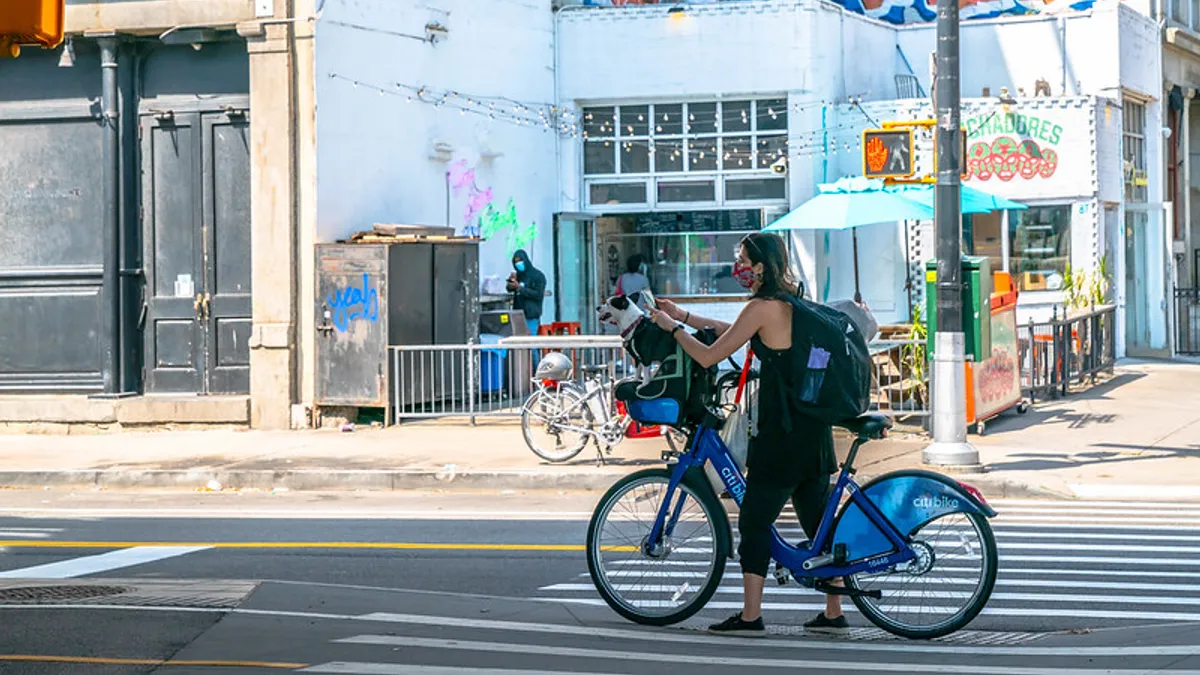Dive Brief:
- Cycling activity increased 11% year-over-year (YOY) on average in September across 100 Census Bureau Statistical Areas (CBSAs), compared to a 6.5% drop in vehicle miles traveled (VMT), according to research from Streetlight Data.
- The biggest gains in cycling ridership this spring occurred in the country’s smaller cities, with short average commute times. Madison, WI, Charlotte, NC, and Greensboro-High Point, NC are among those that noted at least 75% YOY gains in ridership during the June peak. As cycling rates began to decline at the start of the fall and colder months, those areas still saw ridership remain over 50% YOY in September.
- Many U.S. metros with more developed bike infrastructure, however, saw major declines in bike commuting with the onset of stay-at-home orders. "Office buildings downtown emptied, and so did bike lanes normally carrying bike commuters to them," the StreetLight Data e-book writes. Six of the 10 metro-areas with the largest commuting bike miles traveled experienced declines in cycling in 2020.
Dive Insight:
As the pandemic ushered in a new era of cycling, some experts, including StreetLight Data, have seen these ridership trends as a "biking renaissance." But the enthusiasm for cycling has not been felt evenly across cities.
Bike travel made significant gains in smaller cities, but not always in the metro-areas where cycling was previously most popular. Some of the metros that have seen the most commuting bike miles traveled, include: The Ogden-Clearfield, UT; Knoxville, TN; Birmingham-Hoover, AL, Jackson, MS and Des Moines-West Des Moines, IA.
Meanwhile, the metro-areas with the biggest decrease in commuting bike miles traveled include: San Jose-Sunnyvale-Santa Clara, CA; San Francisco-Oakland-Hayward, CA; Boston- Cambridge-Newton, MA; Washington, DC-Arlington-Alexandria, VA; and Los Angeles-Long Beach-Anaheim, CA.
Although those areas with the biggest decrease in activity saw a drop in commuting during the week, there was still largely an increase in weekend cycling for leisure and recreation, according to StreetLight Data Director of Content Phaedra Hise.
"The takeaway there for planners is… people really do want to be on their bikes and maybe they don’t just want to commute to work," Hise said. "Some of these cities might want to consider running analyses to say: 'Where are people riding now? Are they riding on the weekends?' And maybe some of these outlying areas could have some bike infrastructure to encourage leisure activity and suburban bike riding instead of just the city center."
The overall increase in cycling has also supported a surge in road-sport performance bike sales, which saw an 87% YOY increase in June, according to the NPD Group. While comprehensive data for September bike sales is not yet available, the country’s wholesale warehouses stored just 81,000 bikes at the end of August this year compared to almost 600,000 at the same time last year, according to PeopleforBikes.org.
The uptick in cycling has major climate benefits for cities, but it has also introduced some new challenges, namely rising rates of theft. There was a 68% increase in the number of stolen bikes from March through September, according to Bike Index.
As city leaders encourage residents to continue cycling, they will likely need to turn their attention to this growing issue to ensure residents feel safe using bicycles as alternative modes of transportation. The Portland Police Bureau task force, for example, has been working on this issue over the past five years and focuses much of its efforts on bike registration and rider education.












